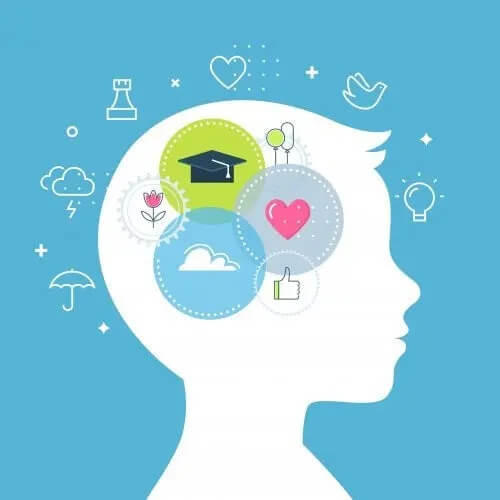Learn About Emotional Education Programs

When we talk about emotional intelligence, the name of American psychologist Daniel Goleman comes to mind. Since the release of his book, Emotional Intelligence, numerous publications have appeared around the world on the subject. Goleman describes emotional intelligence as “the ability to recognize and manage our own feelings, motivate ourselves, and monitor our relationships.” Emotional education programs are implemented for this purpose. In the following article, we’ll tell you all about them.
“All of us have two minds, a thinking mind, and a feeling mind, and these two fundamental forms of knowledge interact to build our mental life.”
– Daniel Goleman –
Emotional education programs
Emotional intelligence is a new form of intelligence that’s complementary to the traditional one. Again, it’s the ability to recognize and manage one’s own feelings and those of others.
Therefore, we can say that a person with high emotional intelligence is better able to feel the emotions they want to feel and to control undesirable feelings. They’re also better able to help other individuals manage their own emotions.
To develop this new type of intelligence, emotional education programs have come into existence. So, we can consider these to be an educational innovation that responds to social needs that ordinary academic subjects don’t address. In addition, a high emotional intelligence favors social relationships and is behind personal and professional success to a great extent.

Why is it important to learn and develop emotional education programs at school?
Currently, there are many experts in psychology, pedagogy, and education who highlight the importance of emotional education within the educational system. They claim that emotional education programs promote the development of different affective-cognitive and social aspects.
Furthermore, research has shown that having good competencies in emotional intelligence brings great benefits to children and adolescents. Therefore, emotional education programs should be present in every classroom of our educational institutions. Among the benefits of emotional education, we can say that it:
- Favors the psychological and emotional well-being of students, as well as their academic performance.
- Reduces disruptive behavior, conflicts, and violence.
- Improves the school and classroom climate and increases motivation, both in teachers and students.
- Finally, it’s an important factor in the prevention and development of some illnesses such as anxiety, depression, eating disorders, drug use, etc.
Aspects to take into account when designing emotional education programs
When planning and developing an emotional education program, it’s important that educators take the following aspects into account:
- The contents vary according to the target audience (educational level, previous knowledge, maturity, etc.).
- Programs are contextualized; the intervention is adapted to each institution according to the analysis of the context.
- They’re open to the inclusion of elements from other programs according to needs.
- Programs are flexible, in the sense of introducing changes based on the results of the evaluation of the implementation process.
- They’re participatory. They have a permanent analysis and reflection of educators through periodic meetings and discussion groups.
Designing emotional education programs
There are several models of emotional education programs. In this article, we’ll look at Goleman’s model: the “mixed model.” This model comprises a series of emotional competencies that help children, adolescents, and even adults to manage emotions towards themselves and others.
To implement an emotional education program we must plan and specify different phases. We’ll start with a justification and a needs assessment. Then, we’ll have to set some objectives, with their respective contents, activities, methodology, and program evaluation.
Objectives of emotional education
First of all, we’ll begin by defining the general objectives of emotional education. According to Bisquerra, they’re the following:

- Acquiring a better knowledge of one’s own emotions
- Identifying the emotions of others
- Developing the ability to control one’s own emotions and produce positive emotions
- Preventing the harmful effects of negative emotions
- Developing greater emotional competence and self-motivation skills
- Adopting a positive attitude towards life
- Learning to flow
Contents of emotional education
Once we’ve defined the general and specific objectives, we specify the contents. Their purpose is to achieve the objectives we’ve established. For this purpose, we’ll work on emotional competencies.
Therefore, we can understand emotional competence as the set of knowledge, skills, and attitudes necessary in order to become aware of, understand, express, and regulate emotions appropriately.
As we said before, we suggest Goleman’s model, the “mixed model,” which is based on the development of the following competencies:
Emotional awareness or self-awareness
This involves becoming aware of and recognizing one’s own emotions and internal state. And, at the same time, it refers to the ability to express emotions through verbal and non-verbal language. The contents that students can work on are emotional vocabulary, identification and recognition of emotions, as well as verbal and non-verbal language.

Emotional regulation or self-control
This involves becoming aware of the relationship between emotion, cognition, and behavior. That is, it implies the control of emotions and responses to each emotional state. We can define emotional regulation as the ability to regulate impulses and unpleasant emotions, to tolerate frustration, and to know how to wait for rewards.
Some strategies of emotional regulation can be internal dialogue, distraction, relaxation, etc. In the same way, students will work on the regulation of emotions and tolerance to frustration.
Motivation
Motivation and emotion go hand in hand and arise from self-control. It’s the ability to direct emotions and motivation towards the achievement of our goals; to be perseverant. And self-motivation is essential to giving meaning to life.
Empathy or the ability to put oneself in another person’s shoes
This is the ability to understand and comprehend the feelings, needs, and concerns of others. To do so, we’ll work on interpersonal relationship skills, expressiveness, communication, cooperation, social collaboration, positive relationships with others, etc.
Socio-emotional skills
When we talk about socio-emotional skills, we’re referring to the set of skills that facilitate satisfactory relationships with other people. People who have good social skills create a good social climate. So, the contents to develop this competence can be interpersonal relationship skills, expressiveness, communication, positive relationships with others, conflict resolution strategies, etc.
Activities and methodology
Next, we choose the methodology and activities that we’re going to propose to carry out our program. Keep in mind that the methodology used in emotional education programs is mainly practical, participatory, and experiential.

Therefore, the most appropriate activities are games (symbolic, cooperative, etc.), relaxation dynamics, modeling, role-playing, or group dynamics. And by using these activities, we help “uncover” the child’s personal history, environment, and needs.
Evaluation
Finally, we must decide on a type of evaluation. Any intervention in emotional education needs evaluation in order to optimize and verify the results. The evaluation instruments we’ll use are:
- Questionnaires and self-reports. These inform us about the beliefs that students have regarding emotions. They also measure the ability to perceive, discriminate and control emotions.
- External observers. These inform us about the interaction between the student and his/her peers. Likewise, they inform us about their way of resolving conflicts or stressful situations.
- Performance measures. These evaluate the way in which the student solves certain emotional problems. It involves comparing their answers with predetermined and objective scoring criteria.
About emotional education programs
Finally, for Bisquerra, having good emotional competencies doesn’t guarantee that they’ll be used to do good and not evil. Therefore, it’s important and necessary for emotional education programs to go hand in hand with ethical and moral principles.
When we talk about emotional intelligence, the name of American psychologist Daniel Goleman comes to mind. Since the release of his book, Emotional Intelligence, numerous publications have appeared around the world on the subject. Goleman describes emotional intelligence as “the ability to recognize and manage our own feelings, motivate ourselves, and monitor our relationships.” Emotional education programs are implemented for this purpose. In the following article, we’ll tell you all about them.
“All of us have two minds, a thinking mind, and a feeling mind, and these two fundamental forms of knowledge interact to build our mental life.”
– Daniel Goleman –
Emotional education programs
Emotional intelligence is a new form of intelligence that’s complementary to the traditional one. Again, it’s the ability to recognize and manage one’s own feelings and those of others.
Therefore, we can say that a person with high emotional intelligence is better able to feel the emotions they want to feel and to control undesirable feelings. They’re also better able to help other individuals manage their own emotions.
To develop this new type of intelligence, emotional education programs have come into existence. So, we can consider these to be an educational innovation that responds to social needs that ordinary academic subjects don’t address. In addition, a high emotional intelligence favors social relationships and is behind personal and professional success to a great extent.

Why is it important to learn and develop emotional education programs at school?
Currently, there are many experts in psychology, pedagogy, and education who highlight the importance of emotional education within the educational system. They claim that emotional education programs promote the development of different affective-cognitive and social aspects.
Furthermore, research has shown that having good competencies in emotional intelligence brings great benefits to children and adolescents. Therefore, emotional education programs should be present in every classroom of our educational institutions. Among the benefits of emotional education, we can say that it:
- Favors the psychological and emotional well-being of students, as well as their academic performance.
- Reduces disruptive behavior, conflicts, and violence.
- Improves the school and classroom climate and increases motivation, both in teachers and students.
- Finally, it’s an important factor in the prevention and development of some illnesses such as anxiety, depression, eating disorders, drug use, etc.
Aspects to take into account when designing emotional education programs
When planning and developing an emotional education program, it’s important that educators take the following aspects into account:
- The contents vary according to the target audience (educational level, previous knowledge, maturity, etc.).
- Programs are contextualized; the intervention is adapted to each institution according to the analysis of the context.
- They’re open to the inclusion of elements from other programs according to needs.
- Programs are flexible, in the sense of introducing changes based on the results of the evaluation of the implementation process.
- They’re participatory. They have a permanent analysis and reflection of educators through periodic meetings and discussion groups.
Designing emotional education programs
There are several models of emotional education programs. In this article, we’ll look at Goleman’s model: the “mixed model.” This model comprises a series of emotional competencies that help children, adolescents, and even adults to manage emotions towards themselves and others.
To implement an emotional education program we must plan and specify different phases. We’ll start with a justification and a needs assessment. Then, we’ll have to set some objectives, with their respective contents, activities, methodology, and program evaluation.
Objectives of emotional education
First of all, we’ll begin by defining the general objectives of emotional education. According to Bisquerra, they’re the following:

- Acquiring a better knowledge of one’s own emotions
- Identifying the emotions of others
- Developing the ability to control one’s own emotions and produce positive emotions
- Preventing the harmful effects of negative emotions
- Developing greater emotional competence and self-motivation skills
- Adopting a positive attitude towards life
- Learning to flow
Contents of emotional education
Once we’ve defined the general and specific objectives, we specify the contents. Their purpose is to achieve the objectives we’ve established. For this purpose, we’ll work on emotional competencies.
Therefore, we can understand emotional competence as the set of knowledge, skills, and attitudes necessary in order to become aware of, understand, express, and regulate emotions appropriately.
As we said before, we suggest Goleman’s model, the “mixed model,” which is based on the development of the following competencies:
Emotional awareness or self-awareness
This involves becoming aware of and recognizing one’s own emotions and internal state. And, at the same time, it refers to the ability to express emotions through verbal and non-verbal language. The contents that students can work on are emotional vocabulary, identification and recognition of emotions, as well as verbal and non-verbal language.

Emotional regulation or self-control
This involves becoming aware of the relationship between emotion, cognition, and behavior. That is, it implies the control of emotions and responses to each emotional state. We can define emotional regulation as the ability to regulate impulses and unpleasant emotions, to tolerate frustration, and to know how to wait for rewards.
Some strategies of emotional regulation can be internal dialogue, distraction, relaxation, etc. In the same way, students will work on the regulation of emotions and tolerance to frustration.
Motivation
Motivation and emotion go hand in hand and arise from self-control. It’s the ability to direct emotions and motivation towards the achievement of our goals; to be perseverant. And self-motivation is essential to giving meaning to life.
Empathy or the ability to put oneself in another person’s shoes
This is the ability to understand and comprehend the feelings, needs, and concerns of others. To do so, we’ll work on interpersonal relationship skills, expressiveness, communication, cooperation, social collaboration, positive relationships with others, etc.
Socio-emotional skills
When we talk about socio-emotional skills, we’re referring to the set of skills that facilitate satisfactory relationships with other people. People who have good social skills create a good social climate. So, the contents to develop this competence can be interpersonal relationship skills, expressiveness, communication, positive relationships with others, conflict resolution strategies, etc.
Activities and methodology
Next, we choose the methodology and activities that we’re going to propose to carry out our program. Keep in mind that the methodology used in emotional education programs is mainly practical, participatory, and experiential.

Therefore, the most appropriate activities are games (symbolic, cooperative, etc.), relaxation dynamics, modeling, role-playing, or group dynamics. And by using these activities, we help “uncover” the child’s personal history, environment, and needs.
Evaluation
Finally, we must decide on a type of evaluation. Any intervention in emotional education needs evaluation in order to optimize and verify the results. The evaluation instruments we’ll use are:
- Questionnaires and self-reports. These inform us about the beliefs that students have regarding emotions. They also measure the ability to perceive, discriminate and control emotions.
- External observers. These inform us about the interaction between the student and his/her peers. Likewise, they inform us about their way of resolving conflicts or stressful situations.
- Performance measures. These evaluate the way in which the student solves certain emotional problems. It involves comparing their answers with predetermined and objective scoring criteria.
About emotional education programs
Finally, for Bisquerra, having good emotional competencies doesn’t guarantee that they’ll be used to do good and not evil. Therefore, it’s important and necessary for emotional education programs to go hand in hand with ethical and moral principles.
This text is provided for informational purposes only and does not replace consultation with a professional. If in doubt, consult your specialist.








